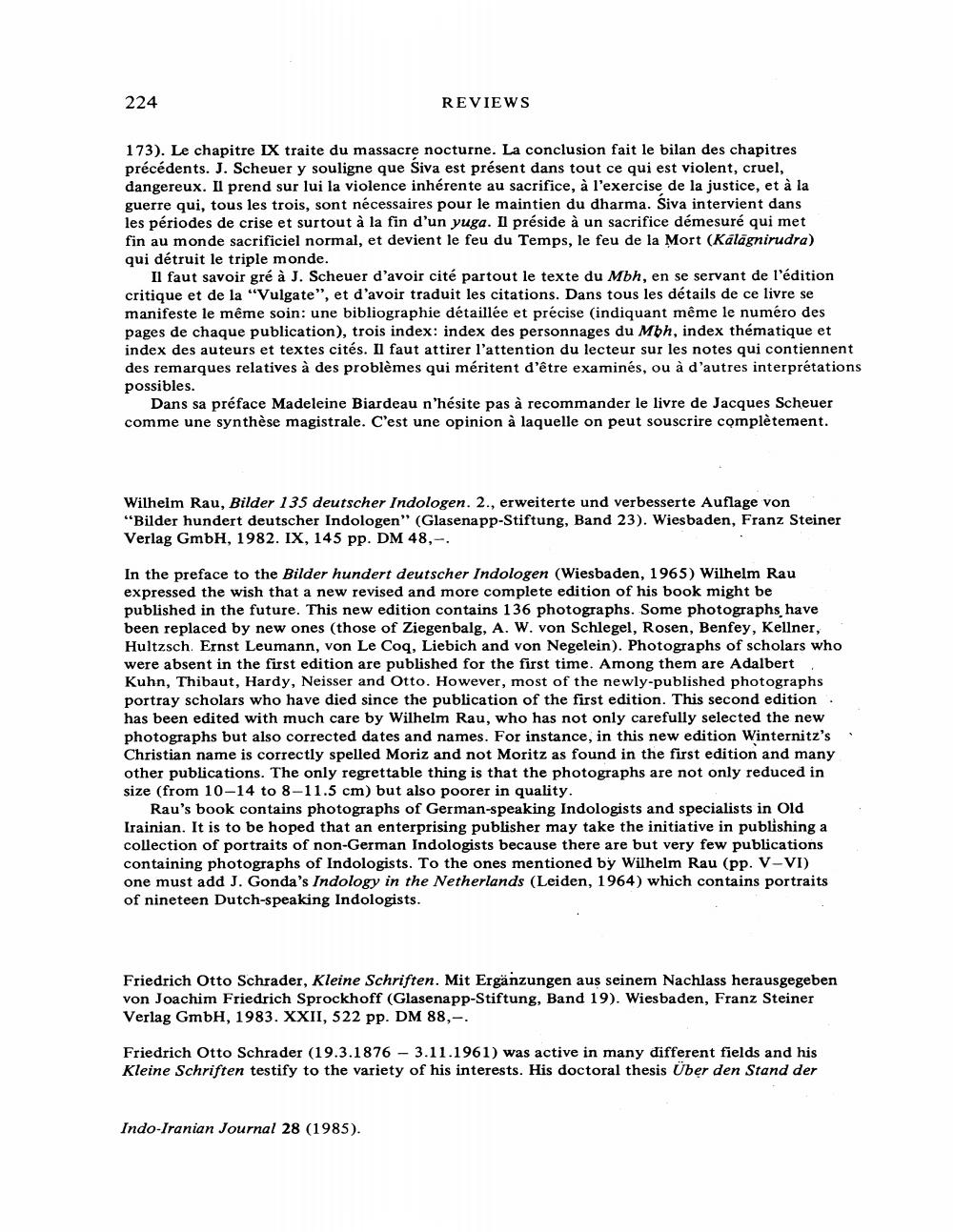________________
224
REVIEWS
173). Le chapitre LX traite du massacre nocturne. La conclusion fait le bilan des chapitres précédents. J. Scheuer y souligne que Siva est présent dans tout ce qui est violent, cruel, dangereux. Il prend sur lui la violence inhérente au sacrifice, à l'exercise de la justice, et à la guerre qui, tous les trois, sont nécessaires pour le maintien du dharma. Siva intervient dans les périodes de crise et surtout à la fin d'un yuga. Il préside à un sacrifice démesuré qui met fin au monde sacrificiel normal, et devient le feu du Temps, le feu de la Mort (Kālāgnirudra) qui détruit le triple monde.
Il faut savoir gré à J. Scheuer d'avoir cité partout le texte du Mbh, en se servant de l'édition critique et de la "Vulgate", et d'avoir traduit les citations. Dans tous les détails de ce livre se manifeste le même soin: une bibliographie détaillée et précise (indiquant même le numéro des pages de chaque publication), trois index: index des personnages du Mbh, index thématique et index des auteurs et textes cités. Il faut attirer l'attention du lecteur sur les notes qui contiennent des remarques relatives à des problèmes qui méritent d'être examinés, ou à d'autres interprétations possibles.
Dans sa préface Madeleine Biardeau n'hésite pas à recommander le livre de Jacques Scheuer comme une synthèse magistrale. C'est une opinion à laquelle on peut souscrire complètement.
Wilhelm Rau, Bilder 135 deutscher Indologen. 2., erweiterte und verbesserte Auflage von "Bilder hundert deutscher Indologen" (Glasenapp-Stiftung, Band 23). Wiesbaden, Franz Steiner Verlag GmbH, 1982. IX, 145 pp. DM 48,
In the preface to the Bilder hundert deutscher Indologen (Wiesbaden, 1965) Wilhelm Rau expressed the wish that a new revised and more complete edition of his book might be published in the future. This new edition contains 136 photographs. Some photographs have been replaced by new ones (those of Ziegen balg, A. W. von Schlegel, Rosen, Benfey, Kellner, Hultzsch. Ernst Leumann, von Le Coq, Liebich and von Negelein). Photographs of scholars who were absent in the first edition are published for the first time. Among them are Adalbert Kuhn, Thibaut, Hardy, Neisser and Otto. However, most of the newly-published photographs portray scholars who have died since the publication of the first edition. This second edition. has been edited with much care by Wilhelm Rau, who has not only carefully selected the new photographs but also corrected dates and names. For instance, in this new edition Winternitz's Christian name is correctly spelled Moriz and not Moritz as found in the first edition and many other publications. The only regrettable thing is that the photographs are not only reduced in size (from 10-14 to 8-11.5 cm) but also poorer in quality.
Rau's book contains photographs of German-speaking Indologists and specialists in Old Irainian. It is to be hoped that an enterprising publisher may take the initiative in publishing a collection of portraits of non-German Indologists because there are but very few publications containing photographs of Indologists. To the ones mentioned by Wilhelm Rau (pp. V-VI) one must add J. Gonda's Indology in the Netherlands (Leiden, 1964) which contains portraits of nineteen Dutch-speaking Indologists.
Friedrich Otto Schrader, Kleine Schriften. Mit Ergänzungen aus seinem Nachlass herausgegeben von Joachim Friedrich Sprockhoff (Glasenapp-Stiftung, Band 19). Wiesbaden, Franz Steiner Verlag GmbH, 1983. XXII, 522 pp. DM 88,-.
Friedrich Otto Schrader (19.3.1876 - 3.11.1961) was active in many different fields and his Kleine Schriften testify to the variety of his interests. His doctoral thesis Über den Stand der
Indo-Iranian Journal 28 (1985).




